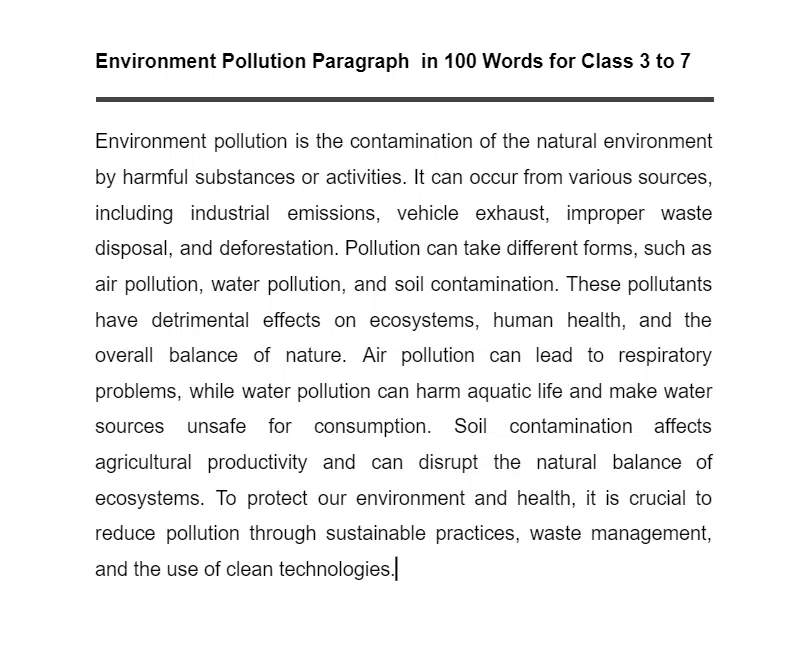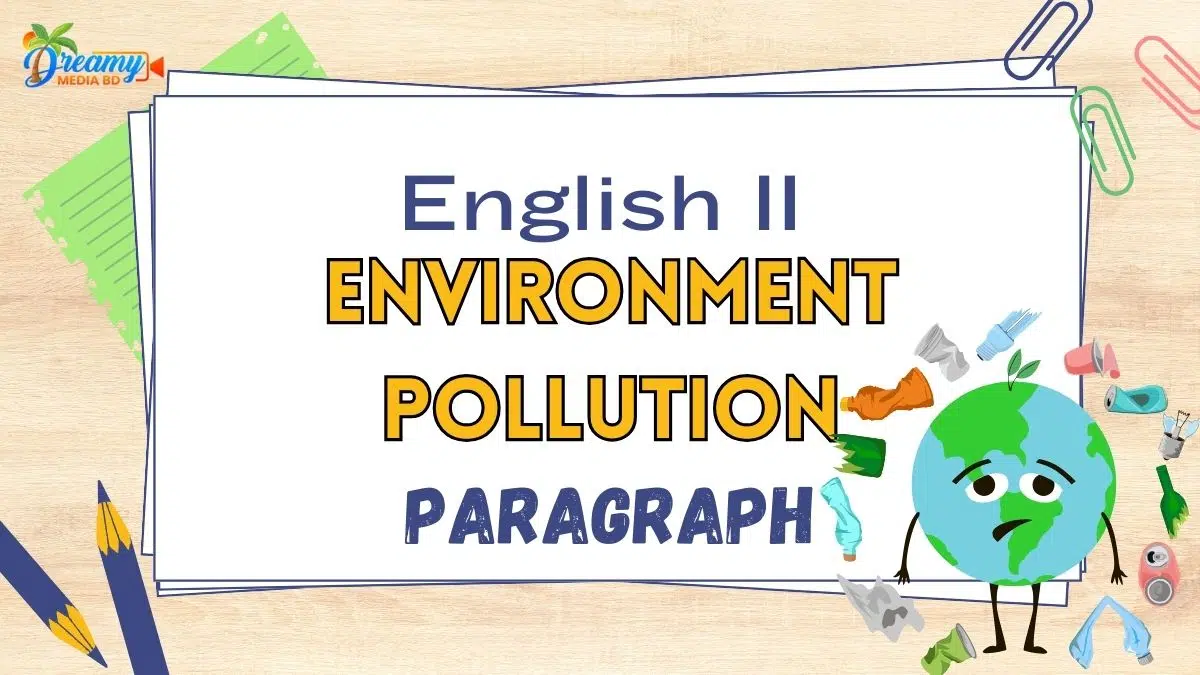Environment Pollution Paragraph for all student
Environmental pollution is the contamination of the natural environment, including air, water, and land, with harmful substances. These contaminants can come from a variety of sources such as industrial activities, transportation emissions, agricultural practices, and improper waste disposal.
Environment Pollution Paragraph in 100 Words for Class 3 to 7
Environment pollution is the contamination of the natural environment by harmful substances or activities. It can occur from various sources, including industrial emissions, vehicle exhaust, improper waste disposal, and deforestation. Pollution can take different forms, such as air pollution, water pollution, and soil contamination. These pollutants have detrimental effects on ecosystems, human health, and the overall balance of nature. Air pollution can lead to respiratory problems, while water pollution can harm aquatic life and make water sources unsafe for consumption. Soil contamination affects agricultural productivity and can disrupt the natural balance of ecosystems. To protect our environment and health, it is crucial to reduce pollution through sustainable practices, waste management, and the use of clean technologies.

Environment Pollution Paragraph in 200 Words For Class 8
Environment pollution is the contamination of the natural environment by harmful substances or activities. It poses a significant threat to the planet and all living beings. Environment pollution has wide-ranging impacts on various aspects of our lives and the natural world. Air pollution occurs when pollutants such as gases and particles are released into the atmosphere, mainly from industrial emissions and vehicles. This pollution can lead to respiratory problems and other health issues. Water pollution happens when pollutants enter water bodies, making the water unsafe for drinking and harming aquatic life. It often stems from improper waste disposal and agricultural runoff. Soil pollution occurs when toxic substances seep into the soil, affecting plant growth and food production. It can result from improper waste disposal and the use of harmful chemicals in farming. Environmental pollution disrupts ecosystems, reduces biodiversity, and has detrimental effects on human health. To combat pollution, sustainable practices, the use of renewable energy, and strict regulations on waste management and emissions are necessary. It is crucial to raise awareness and educate people about the importance of protecting the environment to inspire collective action toward a cleaner and healthier planet.
To address environment pollution, it is crucial to adopt sustainable practices, promote renewable energy sources, and enforce strict regulations on waste management and pollutant emissions. Additionally, raising awareness and educating individuals about the importance of protecting the environment can inspire collective action toward a cleaner and healthier planet.
Environment Pollution Paragraph in 300 Words Class 10 or SSC Exam
Environment pollution is a critical issue that poses significant threats to the planet and all living organisms. It refers to the contamination of the natural environment by harmful substances or activities, leading to adverse effects on ecosystems, human health, and the overall balance of nature.
Air pollution is a major form of environment pollution. It occurs when harmful gases, particulate matter, and pollutants are released into the atmosphere. Industrial emissions, vehicle exhaust, and the burning of fossil fuels contribute to air pollution. These pollutants can have detrimental effects on human health, causing respiratory problems, cardiovascular diseases, and even premature death. They also contribute to climate change by trapping heat in the atmosphere and disrupting weather patterns.
Water pollution is another significant concern. It happens when pollutants contaminate water bodies such as rivers, lakes, and oceans. Industrial waste, agricultural runoff, and improper disposal of chemicals and waste are common sources of water pollution. This pollution not only harms aquatic life but also makes water unsafe for drinking and other essential uses. It can lead to waterborne diseases, ecological imbalances, and the destruction of aquatic ecosystems.
Soil pollution occurs when toxic substances or pollutants seep into the soil. Improper waste disposal, the use of harmful chemicals in agriculture, and industrial activities contribute to soil contamination. This pollution affects soil fertility, hindering plant growth and food production. It can also harm animals and humans if they consume contaminated food or come into direct contact with polluted soil.
Environment pollution has far-reaching consequences. It disrupts ecosystems, reduces biodiversity, and threatens the delicate balance of nature. It also poses significant risks to human health, causing various illnesses and diseases.
To address environmental pollution, it is crucial to adopt sustainable practices and technologies. Additionally, raising awareness and educating individuals about the importance of protecting the environment can inspire collective action towards a cleaner and healthier planet.

Environment Pollution Paragraph in 400 Words For HSC Exam
Environment pollution is a significant and pressing issue that poses serious threats to the planet and all living organisms. It refers to the introduction of harmful substances or activities into the natural environment, resulting in detrimental effects on ecosystems, human health, and the overall balance of nature.
Air pollution is one of the most concerning forms of environment pollution. It occurs when harmful gases, particulate matter, and pollutants are released into the atmosphere. Industrial emissions, vehicle exhaust, and the burning of fossil fuels are major contributors to air pollution. These pollutants can have severe impacts on human health, leading to respiratory problems, cardiovascular diseases, and even premature death. Moreover, air pollution plays a significant role in climate change by trapping heat in the atmosphere and contributing to global warming.
Water pollution is another critical aspect of environment pollution. It takes place when pollutants contaminate water bodies, such as rivers, lakes, and oceans. Industrial waste, agricultural runoff, improper disposal of chemicals, and sewage discharge are common sources of water pollution. This pollution not only harms aquatic life but also makes water unsafe for drinking and other essential uses. It can lead to the spread of waterborne diseases, ecological imbalances, and the destruction of marine ecosystems.
Soil pollution is yet another concerning form of environment pollution. It occurs when toxic substances or pollutants enter the soil, often due to improper waste disposal, the use of harmful chemicals in agriculture, and industrial activities. Soil pollution impacts soil fertility and can hinder plant growth and food production. It also poses risks to animals and humans, as they may consume contaminated food or come into direct contact with polluted soil.
The consequences of environment pollution are far-reaching. It disrupts ecosystems, reduces biodiversity, and poses a threat to the delicate balance of nature. It also has significant implications for human health, leading to various illnesses, respiratory problems, and long-term health issues.
Addressing environment pollution requires collective action and proactive measures. Governments, industries, and individuals must adopt sustainable practices and technologies. This includes reducing reliance on fossil fuels, promoting renewable energy sources, implementing effective waste management systems, and enforcing strict regulations on pollutant emissions. Additionally, raising awareness and educating individuals about the importance of protecting the environment can inspire positive change and collective action towards a cleaner and healthier planet.
By taking steps to mitigate environment pollution, we can safeguard ecosystems, protect human health, and preserve the planet for future generations. It is a shared responsibility that requires the collaboration and commitment of all stakeholders to create a sustainable and thriving environment.

Environment Pollution Paragraph in 500 Words for any competition exam
Environment pollution is a major concern that affects the health and well-being of both humans and other living beings on the planet. It is defined as the contamination of air, water, and soil by substances that are harmful to the environment. With the rapid increase in industrialization, urbanization, and modernization, our planet has become more vulnerable to environmental pollution.
Air pollution is one of the most significant forms of environmental pollution. It is caused by the release of harmful substances such as carbon monoxide, sulfur dioxide, and nitrogen oxides from factories, power plants, and vehicles. These pollutants not only affect human health but also have a severe impact on ecosystems and contribute to climate change.
Water pollution is another major concern that affects our planet. It is caused by dumping of untreated sewage, industrial waste, and agricultural runoff into rivers, lakes, and oceans. This pollution not only affects marine life but also contaminates drinking water sources for humans. The increasing levels of pollutants in our oceans have led to the formation of dead zones – areas where no marine life can survive. Furthermore, the contamination of groundwater sources due to improper disposal of waste has led to a shortage of safe drinking water in many parts of the world.
Soil pollution is also a significant environmental issue. It is caused by the use of pesticides, fertilizers, and other chemicals in farming practices. These substances not only deplete the soil’s nutrients but also contaminate it, making it unsuitable for growing crops. The improper disposal of electronic waste and other non-biodegradable materials also contributes to soil pollution. This pollution not only affects agriculture but also disrupts the balance of ecosystems.
Environmental pollution has a detrimental impact on the health of humans and other living beings. Air pollution can lead to respiratory diseases, cardiovascular problems, and even cancer. Water pollution can cause gastrointestinal illnesses and infections due to the consumption of contaminated water. It is estimated that around 2 million people die each year due to unsafe drinking water. Soil pollution can lead to a decrease in crop production, which can have severe consequences on food security. Moreover, the chemicals used in farming practices also enter the food chain and can cause health issues for humans and animals alike.
Furthermore, environmental pollution has a significant impact on ecosystems and biodiversity. The contamination of water sources leads to the decline or extinction of aquatic species. Air pollution not only affects plants but also disrupts the pollination process, which can lead to a decrease in food production. Soil pollution not only depletes soil nutrients but also results in the loss of beneficial microorganisms and insects, affecting plant growth. These disruptions ultimately have a severe impact on the balance of ecosystems and can even cause species extinction.
Thus, it is evident that environmental pollution has far-reaching consequences that go beyond human health. It affects every living being on the planet and disrupts the delicate balance of nature. Therefore, it is crucial to take immediate action to reduce environmental pollution through sustainable practices. Governments, industries, and individuals must work together to find solutions and implement measures such as proper waste management, use of renewable energy sources, and reducing carbon emissions.By taking these steps, we can protect the environment and ensure a better future for generations to come.

Environment Pollution FAQS
- What is environment pollution?
Environment pollution refers to the contamination of our natural environment by harmful substances and waste products. It can be caused by human activities, such as industrialization, transportation, and agriculture.
- What are the main types of environment pollution?
The main types of environment pollution are air pollution, water pollution, soil pollution, noise pollution, and light pollution. Each type has its own specific causes and effects on the environment.
- How does air pollution affect the environment?
Air pollution can have severe impacts on both human health and the environment. It is caused by emissions from vehicles, factories, and burning of fossil fuels. These emissions contain harmful substances such as carbon monoxide, sulfur dioxide, and nitrogen oxide, which can cause respiratory diseases and damage to plants and animals.
- What are the sources of water pollution?
Water pollution is caused by various sources including industrial waste, chemical fertilizers and pesticides from agriculture, sewage and wastewater from households, and oil spills from ships. These pollutants can contaminate our water bodies, making it unsafe for drinking and harming aquatic life.
- How does soil pollution occur?
Soil pollution occurs when harmful substances are added to the soil through human activities. These can include industrial waste, agricultural chemicals, and improper disposal of household waste. This can lead to a decrease in soil fertility and harm plants and animals that rely on the soil for survival.
- What are the effects of noise pollution?
Noise pollution is caused by loud sounds from various sources such as transportation, construction, and industrial activities. Prolonged exposure to high levels of noise can cause hearing loss and other health issues. It can also disrupt wildlife behaviors and affect the balance of ecosystems.
Also read: Early Rising paragraph














